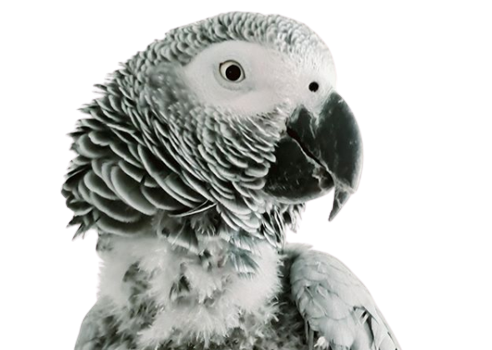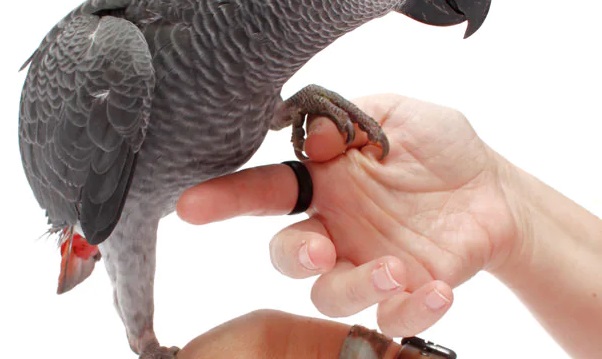Dear Grey Lovers!
I have received lots of messages and noticed lots of questions about how to have your bird step up. I thought I would write a quick post in here and hopefully this will help!
“Teach your parrot to obey your every command with these expert tips! Learn how to train your feathered friend to step up or down with ease. Say goodbye to frustrating bird behavior and say hello to a well-behaved parrot today!”
Just as you train a young puppy to “sit” as one of his first commands, there is a first command you need to teach all pet psittacine birds. That first command is “step up.” It is an easy command to teach a bird because the physical motion is something he normally does many times during the day.
By teaching your bird this command, you will decrease any fear the bird may have of you, reinforce the bond between you and the bird, establish your authority, have better control over the bird, and decrease the chance the bird will become territorial.
After the bird begins to learn the command, he/ she will relate it to good things happening, such as attention from you, treats, and eventually rewards such as going to the “play gym.”
Stepping Up!
The step up command is the most important command to teach your bird as it gives you some control over him/ her and helps you to interact with the bird. Many birds will have learned how to step up before you get them home, but if they haven’t then this short guide should help you.
1. Choose the command you want to use and stick with it. It can be as simple as Step Up but it should not be a question and should be short and sharp.
2. Choose a time to train when you have the birds complete attention. You may need to go into a neutral room such as a bathroom away from the cage to begin training. Make sure there are no distractions for the bird’s attentions such as other pets, or people.
3. Hold your hand at the bird’s abdomen above the feet and give the Step Up command. The bird should step up. If he doesn’t try pressing lightly on the birds abdomen.
4. When he or she steps up give him/ her lots of praise and his/ her favorite treat. As the bird gets better at stepping up you can decrease the treats, but keep praising.
5. You can have the bird step from hand to hand to practice. But when you see the bird is getting tired or losing concentration, stop at the next successful step up, give lots of praise and end the session by offering the treat.
6. When it seems the bird has mastered the step up away from the cage you can begin practicing it from inside the cage.
7. Have different family members practice the step up with the bird
A couple of things to remember when you are teaching your bird to step up;
1. Never get cross with your bird, always be positive and ignore any unwanted behavior
2. Keep the practice sessions short, but frequent.
3. If the bird appears to be going to bite your hand, relax, he/ she may just be testing to make sure the perch (your hand) is stable. If he/ she does bite, say firmly NO biting! but keep your hand steady. Use a perch as a last resort.
4. If the bird doesn’t want to step up, or understand what you are expecting him or her to do a gentle push on his belly will help the bird to make the step. When he/ she steps up, remember lots of praise and treats in the early stages!
5. And lastly remember if a step up always results in a negative outcome such as being returned to the cage, your bird may start refusing to step up. Keep stepping up fun!
The above was a quick guide for those who do not like to write long posts, however below I am writing the same thing but with more details so that everyone out there who reads this post can understand perfectly. Now, it’s a matter of putting those altogether to have the parrot step up onto our hand.
Bird Training: First Steps
If the bird is not used to you, for several sessions you may want to just slowly and quietly place your hand in the bird’s cage, away from the bird. When you approach the cage, and work with the bird, you should always be slightly higher than the bird’s eye level.
Too far above, and the bird may be more afraid. Too low, and the bird may start to interpret it as submission on your part. With each session, move your hand closer to the bird, and allow the bird to perch on it of his own accord (you may want to tempt him with a treat).
Once your bird is comfortable with your hand close to him in the cage, the real training can start.
If the bird is large and already a biter, you may wish to use a dowel or other stick in place of your finger during initial training. If so, get the bird used to the dowel by placing it in the cage and allowing him to investigate it.
Teaching Your Bird to “Step Up”
First, get your bird used to taking special, very tasty treats from your hand. These types of treats should be reserved for training purposes.
Next, by holding a treat in one hand, lure the bird to come closer to the “step up” hand, which is held in front of the bird at a higher level than the perch. At first, you will want to reward the bird for simply coming close to the “step up” hand.
When the bird starts to step onto your hand, say “Step up” or “up.” Either command is fine, but choose only one and say it each time the bird steps up. Consistency is the key – all family members, and you, need to do it the same way every time.
When the bird steps up, praise him and give him a very small treat – something he/ she really likes, but only gets when he obeys a command. At first, you may reward the bird for only putting one foot on the “step up” hand.
Larger birds may use their beaks to help them step up. Do not pull away if the bird uses his beak on your finger or appears he will bite. This is true for smaller birds as well. He may soon learn you are afraid of that, and then he has you right where he wants you. Do not let the bird think you are afraid of him. Also, he will not want to obey a command to “step up” if the bird thinks the finger or dowel may be pulled out from underneath him or her.
As the bird becomes comfortable, take him out of the cage and continue the training in other quiet environments. When away from his cage or territory, he may feel more vulnerable, and pay more attention to you.
Teaching Your Bird to “Step Down”
When you wish to have the bird step off of your finger or dowel, place whatever you want him to step onto, e.g.; a perch in the bird’s cage in front of him. You will need to use the same technique you use for a “step up”; with a treat, lurre the bird onto the object you want him to step onto.
The object should be in front of the bird and higher than your hand. Have the bird face you and step onto the object while you give the command “step down” or “down.” Again, either command is fine, just be consistent.
When moving from your finger to the object, the bird is actually stepping upwards, but the command should still be “step down,” which really means, “move from my finger to what I am showing you.” Again, the bird will probably use his beak to help accomplish the “step down,”.
Teaching Your Bird to “Laddering”
When the bird has learned “step up,” it is time to teach the bird to “ladder.” This means having the bird step up from the finger of one hand to a finger on the other hand, which is held higher. Each step should be accompanied by the “step up” command. The bird should become accustomed to doing this repeatedly. This is a command which should be repeated on a daily basis.
Teaching “step ups” is key to successfully training a bird. It is a command every bird should know. This one command will help establish a great life-long relationship between you and your bird from the very beginning.
Whether you own an African Grey, Macaw, Cockatoo, Eclectus or any other kind of parrot, training your parrot to step up onto your hand is the first behaviour she will learn. It helps your parrot to trust you.
You need a pet bird to perform this basic behaviour reliably. Without step-up you cannot move the bird from one place to another; you cannot put it in a crate. Your social interactions with it are severely limited. A novice bird for example may have been hand reared or parent reared by a breeder.
If you are wise and lucky enough to choose a conscientious breeder the chick will already have learned to trust people and possibly know the basic command of step up and step down. If it doesn’t you start from scratch.
There are two hand positions:
Palm vertical so that the bird steps onto the forefinger as if it were a branch and palm horizontal.
The right position for your hand is directly in front of the bird and higher than the level of the perch. How much higher is a matter of judgement. Obviously, the longer the bird’s legs, the larger its claws, the wider the distance will be. The distance never needs to be more than a few centimeters.
Your hand height:
Always and I mean always, place your hand, whether vertical or horizontal, slightly higher than the bird’s claws. Because of their body shape, it is much easier for a bird to step higher than to step lower.
If you watch birds carefully, they avoid stepping down. If you hold your hand lower than the perch, the bird is reluctant to step down. Raise your hand to her lower chest level and she will step up (willingly I hope). Then the treat is offered.
Don’t get too close to the bird – try to ‘think like a parrot’.
In their eyes we are huge creatures with eyes in front of our faces like hawks, rats and other predators. So position yourself so that you don’t crowd your companion.
Stretch out your hand slowly and in your other hand keep the treat – a favorite snack, a nut or a toy. You may show the bird the treat as a lure but once training has progressed you keep the treat hidden. Birds make rapid movements themselves but they prefer us to use slow steady ones.
Closing Notes;
Should you let your parrot on your shoulder?
Most trainers will tell that you should never allow the bird on your shoulder because: You cannot see what the bird is up to It is too near your face should it try to bite However, that said, you will often see pictures of the same trainers with a bird on their shoulder. Many of us who have birds that we trust let them on our shoulders.
If you found this blog helpful, It would be great if you could share it with your family and friends who might find it useful as well.
For more useful content about African Grey parrots, you can subscribe my site with your email to get notification upon publishing a new blog, the subscribe box you can see on the right side of this page. Also if you get an alert on your web browser while browsing my site, allow it and that will also give you an alert whenever I publish a new blog.
Stay safe and much love !




